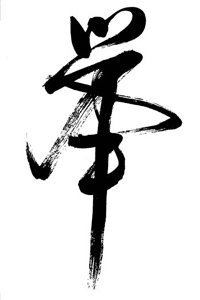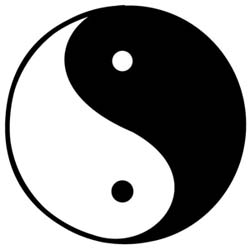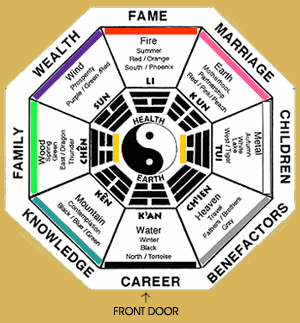![]()
contributed by Joyce Kocinski, Allied Member ASID [designer / Feng Shui consultant / principal of Design In Balance]
Last month we discussed the history of Feng Shui, how an interior designer can make use of it in his or her practice, and what kind of consumers are intrigued by the concept.  If your dog didn’t eat the “homework” that we assigned you in the previous installment, then you’ll be ready to evaluate that particular space according to Feng Shui interior design principles, which use a set of rules for furniture placement, color, and balance — not only for the overall space plan, but also for each individual space.
If your dog didn’t eat the “homework” that we assigned you in the previous installment, then you’ll be ready to evaluate that particular space according to Feng Shui interior design principles, which use a set of rules for furniture placement, color, and balance — not only for the overall space plan, but also for each individual space.
Room By Room
Starting in the bedroom, the bed should have a view of the door if possible; however, if it cannot face the door, a mirror can be hung on the wall perpendicular to the bed to reflect the entrance. This condition allows the inhabitant to be able to see who enters the room and not be startled or taken off guard. The arrangement is called the “Command” position and also works with an office or home office, allowing the desk to have a view of the door.
In the kitchen, the stove represents wealth of the home, so the cook should also have a view of the entrance of the room. If that is not possible, a mirror can be hung  over the stove to help the cook see who enters the room. An island stove is good placement because it allows the cook to see her guests. All burners of the stove should be in working order. If they are not, they should be repaired quickly.
over the stove to help the cook see who enters the room. An island stove is good placement because it allows the cook to see her guests. All burners of the stove should be in working order. If they are not, they should be repaired quickly.
Living rooms should have furniture arranged for the comfort and conversation of the people using it. The room may have different groupings if it suits the owners. Again, the Command position applies here, and the person in the primary seat should have full view of the room’s entrance. A sofa and loveseat can be placed either opposite one another or in an L-shape. Angling the sofa on a diagonal is acceptable as long as a table or plant is placed behind it. It is important not to block any doorways or traffic patterns from one room to the next. That way, if the living room adjoins the kitchen, people and chi (a.k.a. energy) can flow easily between rooms.
Hallways in a home conduct chi and can be manipulated with Feng Shui to either slow down or speed up this energy flow. A long hallway supposedly has quick flowing chi, but the ideal is a gentle flow. One cure for this is to hang a crystal in the middle of the hallway’s ceiling to slow down the chi. Also, a door at the end of a long hallway creates fast-flowing chi, so one can put a mirror on the door to deflect the chi.
The entrance of a home is a very important area and gives the opportunity for the chi to enter. First off, the entrance should be well lit and uncluttered. A narrow entrance can be improved by hanging a mirror on the wall. If the entrance leads to another door, the chi can be deflected by hanging wind chimes or placing a crystal ball near the entrance.
Go With The Positive Energy Flow
According to Feng Shui principles, negative energy is caused by certain structural conditions in the home. These problems areas are beamed ceilings, projecting corners, slanted walls, and square columns. If the beams are truly functional and not  merely decorative and, therefore, cannot be removed, then paint them to blend in with the ceiling color or move furniture away from that area. To soften the sharp corners of a square column, hang a mirror or trail a vine so that it covers the edge.
merely decorative and, therefore, cannot be removed, then paint them to blend in with the ceiling color or move furniture away from that area. To soften the sharp corners of a square column, hang a mirror or trail a vine so that it covers the edge.
Good Feng Shui in the home means keeping control of clutter in rooms as much as possible. Stagnant energy builds up in rooms that are not used for long periods of time. Clutter in general is not conducive to a relaxed and pleasant home. The goal would be to get rid of unused items or get proper storage for seasonal clothes, etc.
For example, some people save clothes for years that don’t fit, and this hoarding takes up unnecessary space. Donating them to charities frees up closet space and allows energy to flow freely. The same rule can be applied to other items in the home such as old books, magazines, etc. The less clutter, the better the energy flow through a room.
The Cures
In the practice of Feng Shui there exist nine symbolic “cures” to help correct problems within a space. Cures are objects used to enhance or improve the energy flow in a room, and they can be both literal and symbolic in nature: color, electric  power, light, living things, moving things, sound, symbolic objects, weight, and other objects that are very symbolic only on a deep, personal level. The following suggestions are different items that can be used as remedies for a stagnant space, helping to balance the energy and breathe in life.
power, light, living things, moving things, sound, symbolic objects, weight, and other objects that are very symbolic only on a deep, personal level. The following suggestions are different items that can be used as remedies for a stagnant space, helping to balance the energy and breathe in life.
- Wood objects (furniture, statues, etc.).
- Metal elements (wind chimes, statues, musical instruments).
- Fire elements (plants, pets, candles).
- Water elements (fountains, aquariums, mirrors).
- Earth objects (statues, ceramic objects, plants).
Think back on the questions we posed in last month’s installment. Are the traffic patterns blocked in your living room” Is your office overflowing with stacks of unfiled papers and unorganized bookshelves” Does the layout in your bedroom lead to uneasy sleep and unwelcome arguments between you and your partner” If the space that you evaluated feels depressed in some way, then you might want to first look for cures in the examples of each of the five elements.
Looking Ahead
Think harder on your space evaluation because next month we will cover specific scenarios for these curative objects. We’ll also be wrapping everything up by covering the other vital remedies for a dull, lifeless space — the ever important elements of color and light. GO HERE TO READ PART 3 OF THIS ARTICLE.
Resources


